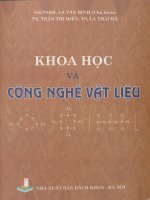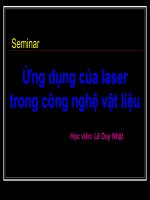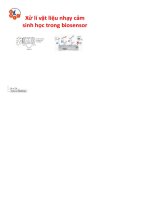Công nghệ vật liệu trong y sinh học biom aterials chapter 2 phần 2 8
Bạn đang xem bản rút gọn của tài liệu. Xem và tải ngay bản đầy đủ của tài liệu tại đây (3.34 MB, 20 trang )
Chap.2. –
2.8. Composites
ng
.c
om
Important Note: Reaction of the tissues to implant materials !
co
Principle for material selection
Advanced Program Biomedical Engineering – HUST, Vietnam
ng
th
an
1
du
o
Chap.2. –
2.8. Composites
Composite: Composite materials are those that contain two or more distinct constituent
materials or phases, on a microscopic or macroscopic size scale
u
•Matrix: phase which is continuous and surround the other phases
cu
•Dispersed phase: discontinuous phases reinforcement, filler
•Examples:
- reinforced plastics (artificially made)
- wood, bone, cartilage, skin, tendon etc. (natural composite): often exhibit hierarchical
structure
Note: alloys (brass) or metals (steel with carbide particles): are not composite
•Properties depend very much upon structure. In particular, properties depend on the shape
of heterogeneities, volume fraction and interface
Properties of composite depend on: - Properties of Matrix
- Properties of dispersed materials
- Interface adhesion
- Biocompatibility (for biomaterials)
•Classification: based on the form of reinforcement (particulate, fibrous composite, laminates)
2
CuuDuongThanCong.com
Advanced Program Biomedical Engineering – HUST, Vietnam
/>
2.8. Composites
ng
.c
om
Chap.2. –
co
Simplest classification of composite materials
Advanced Program Biomedical Engineering – HUST, Vietnam
ng
th
an
3
2.8. Composites
cu
u
du
o
Chap.2. –
Other more detailed classification of composites
4
CuuDuongThanCong.com
Advanced Program Biomedical Engineering – HUST, Vietnam
/>
Chap.2. –
2.8. Composites
co
ng
.c
om
Morphology of composites
Advanced Program Biomedical Engineering – HUST, Vietnam
ng
th
an
5
du
o
Chap.2. –
2.8. Composites
Reinforcements (Reinforcing systems)
u
Main reinforcements used in biomedical composite are carbon fibers, polymer fibers,
ceramics and glasses
cu
Carbon fibers
•Carbon fibers
- Light, flexible, high-strength, high-tensile-modulus (d = 1.7-2.1 g/cm3, strength up
to 4.5 GPa, elastic modulus up to 900 GPa)
- Poor shear strength
- Production: by pyrolysis of organic precursor fiber (rayon, PAN, and pitch) in innert
environment
Note: different between carbon and graphite fibers (93-95% carbon and more than 99%)
•Composite: Lightness & high mechanical properties for load-bearing medical devices
•Examples:
- Short carbon fiber reinforced UHMWPE: for orthopedic application
- In the 1980s: carbon fiber have been used for develop scaffolding device to indice
tendon or ligament repair
6
CuuDuongThanCong.com
Advanced Program Biomedical Engineering – HUST, Vietnam
/>
Chap.2. –
2.8. Composites
Polymer fibers
Mainly aramid, UHMWPE fiber (strong and stiff), PET for some applications (biocompatibility,
high strength and fatigue resistant), certain degradable fibers
•Aramid (Kevlar, Nomex, Twaron)
- Aramid fibers: light (d=1.44 g/cm3), stiff (modulus can go up to 190 GPa), strong (tensile
strength about 3.6 GPa), resist impact and abrasion damage, but poor compressive and
absorb moisture
- Composite: high tensile strength and stiffness, damage resistance, resistance to fatigue
and stress rupture; in medicine mainly for dentistry and ligament prostheses
.c
om
•UHMWPE (Spectra, Dyneema, Toyobo): Mw > 106
- Fibers: produced by gel-spinning technique from 2-8%w solution (in decalin) at 130140oC; highest specific strength of all commercial fibers available to date; high modulus; light
weight (d=0.97 g/cm3), high energy dissipation ability; resist abrasion and do not absorb
water; but poor surface properties for other resins to adherence; low-temperature fabrication
co
ng
- Bulk composite: extensive application in bearings for joint prostheses (excellent
compatibility but with life time restrict by its wear resistance); PE reinforced acrylic resins: in
dentistry, for intervertebral disc prostheses, fabrication of ligament augmentation devices
Advanced Program Biomedical Engineering – HUST, Vietnam
ng
th
an
7
du
o
Chap.2. –
2.8. Composites
•PET – Poly(ethylene terephthalate)
cu
u
- PET Fibers (Dacron): have several biomedical uses, most in cardiovascular surgery
for arterial grafts, proposed in orthopedics for fabrication of artificial tendon or ligaments
and ligament augmentation devices (as fiber alone or in composite), proposed for soft
tissue prostheses, intervertebral discs
•PLA & PGA and their copolymers (biodegradable)
- Biodegradable fibers: for biodegradable sutures, properties depend on several factors
- Combination of fibers and tissue: proposed for ligament construction, scaffold for
tissue engineering
- Composite: in combination with parent matrix: for intramedullary biodegradable pins
and plates, biodegradable scaffold for bone regeneration
Ceramics
- many different ceramics are used for reinforcing biomedical composite, in form of
particulate
- relative week & brittle compared to metals (in tension or shear loaded)
- various calcium phosphates: most intensively studied system, particular those with
Ca/Phosphorus ratio of 1.5-1.67; tricalcium phosphates Ca3(PO4)2 (whitlockite) and
hydroxyapatite Ca10(PO4)6(OH)2 are used clinically for dental & orthopedic applications
8
Advanced Program Biomedical Engineering – HUST, Vietnam
CuuDuongThanCong.com
/>
Chap.2. –
2.8. Composites
- aluminum- and zinc-based phosphates, glass and glass-ceramics, and bone minerals
Glasses
- Glass fibers: widely used for forming structural and molding compounds, high strength-toweight ratio, good dimension stability, good resistance to heat, cold, moisture and corrosion,
good electrical insulation properties, easy to fabrication, relative low cost
- In biomedical application: dentistry (reinforcing acrylic resin for higher mechanical
properties), degradable matrix reinforced by calcium phosphate glass fibers as implant
materials
For biomedical use: mostly thermoplastics polymeric matrix
•Synthetic nondegradable polymers & composites
.c
om
Matrix system and their composites (Note: see 2.2.Polymers)
- PEEK – poly(ether ether keton), UHMWPE, PTFE-polytetraflourethylene, PMMA,
hydrogels: most common used
ng
- Usually reinforced with carbon fibers, PE fibers and ceramics, or reinforced with
paticulate or choped fibers: used for prosthetic hip stems, fracture fixation devices, artificial
joint bearing surfaces, artificial tooth roots, bone cements
co
- Generally used to provide specific mechanical properties unattainable with homogeneous
materials
Advanced Program Biomedical Engineering – HUST, Vietnam
ng
th
an
9
du
o
Chap.2. –
2.8. Composites
- Total joint replacement: important application, can get a large range of mechanical
properties by using different matrix reinforced with carbon fibers
cu
u
(Note: cases of carbon fiber/polysulfone and epoxy/carbon fibers)
10
CuuDuongThanCong.com
Advanced Program Biomedical Engineering – HUST, Vietnam
/>
Chap.2. –
2.8. Composites
Absorbable polymers and their composites:
- From PLA, PGA, copolymer from them: implants for the repair of variety of osseous and
soft tissues, satures; DMTMCs-dimethyltriethylene carbonates, polydioxanone,
polycaprolactone, poly(amino acids)
- Fracture fixation
Note: disadvantages of rigid fixation devices (metals and alloys) and problems during healing (stress
protection atrophy, very different elastic modulus between bone & metals/alloys, corrosion…)
. Degradable mechanically with time, reducing stress protection and the accompanying
osteoporosis
.c
om
. No need to secondary surgical procedure to remove absorbale devices
. From PLLA, PGA, polydioxanone (unreinforced: tension: 36%, bending: 54%, stiff: 3%
compared with that of stainless steels; higher with reinforcement)
co
ng
. Self-reinforced PLLA(SR-PLLA) and self-reinforced PGA (SR-PGA): using sintering
technique, commercial available; for treatment of fracture and osteotomies
Advanced Program Biomedical Engineering – HUST, Vietnam
ng
th
an
11
2.8. Composites
cu
u
du
o
Chap.2. –
12
CuuDuongThanCong.com
Advanced Program Biomedical Engineering – HUST, Vietnam
/>
2.8. Composites
co
ng
.c
om
Chap.2. –
Advanced Program Biomedical Engineering – HUST, Vietnam
ng
th
an
13
du
o
Chap.2. –
2.8. Composites
Fabrication
1. Hand-lay-up
u
2. Spray up
cu
3. Compression molding
4. Resin transfer molding
5. Injection molding, extrusion
6. Filament winding
7. Pultrusion
•
For particle-reinforced composites: compression molding, injection molding, extrusion
most common; in some applications in situ (dental restorative composites & particlereinforced bone cements
•
For fiber-reinforced composites: vacuum bag-autoclave process, filament winding, closedmold presses
14
CuuDuongThanCong.com
Advanced Program Biomedical Engineering – HUST, Vietnam
/>
2.8. Composites
co
ng
.c
om
Chap.2. –
Advanced Program Biomedical Engineering – HUST, Vietnam
ng
th
an
15
du
o
Chap.2. –
2.8. Composites
Mechanics of composites
cu
u
* Mechanical properties in many composite materials depend on structure in a complex
way, however for some structures the prediction of properties is relatively simple by using
Voigt and Reuss models
16
CuuDuongThanCong.com
Advanced Program Biomedical Engineering – HUST, Vietnam
/>
Chap.2. –
2.8. Composites
Calculate the stiffness of materials with Voigt and Reuss structures:
.c
om
Young modulus E of the Voigt composites is (neglecting restrain due to Poisson’s ratio:
This is less than that of Voigt model.
co
ng
The Voigt and Reuss formulae constitute upper and lower bounds, respectively, upon the
stiffness of the composite of arbitrary phase geometry
Advanced Program Biomedical Engineering – HUST, Vietnam
ng
th
an
17
du
o
Chap.2. –
2.8. Composite
cu
u
Calculate the properties of several composite material structures
structures
18
CuuDuongThanCong.com
Advanced Program Biomedical Engineering – HUST, Vietnam
/>
Chap.2. –
2.8. Composites
Rule of mixtures:
Ec = EfV f + EmVm = EfVf + Em(1-Vf)
Properties of some composites
co
ng
.c
om
- In orthopedic implant
Advanced Program Biomedical Engineering – HUST, Vietnam
ng
th
an
19
du
o
Chap.2. –
2.9. Ceramics, glasses, and glassglass-ceramics
Ceramics, glass and glass-ceramics:
- include a broad range of inorganic/nonmetallic compositions
cu
u
- essential for eyeglasses, diagnostic instruments, chemical ware, thermometer, tissue
culture flasks, fiber optics for endoscopy; insoluble porous glasses: as carrier for enzymes,
antibodies and antigens
- Advantages: resistant to microbial attack, pH changes, solvent conditions, temperature
Bioceramics
•Ceramics are refractory, polycrystalline compounds, usually inorganic, including silicates,
metal oxides, carbides and various refractory hydrides, sulfides and selenides
•Ceramics can be classified according to their structural compounds, of which A mXn is an
example (A;metal, X:nonmetal)
20
CuuDuongThanCong.com
Advanced Program Biomedical Engineering – HUST, Vietnam
/>
Chap.2. –
2.9. Ceramics, glasses, and glassglass-ceramics
•Ceramics are generally hard, have high melting temperatures and low conductivity of
electric and heat
co
ng
.c
om
•Ceramics are difficult to shear plastically (due to the ionic nature of bonding)
brittle,
creep at room temperature almost zero and very sensitive to notches or microcracks, low
tensile strength compared to compressive strength
Advanced Program Biomedical Engineering – HUST, Vietnam
ng
th
an
21
du
o
Chap.2. –
2.9. Ceramics, glasses, and glassglass-ceramics
Types of bioceramics - tissue attachment
cu
u
There are four types of tissue response and four different mean of attaching prostheses to
skeletal system:
22
CuuDuongThanCong.com
Advanced Program Biomedical Engineering – HUST, Vietnam
/>
2.9. Ceramics, glasses, and glassglass-ceramics
co
ng
.c
om
Chap.2. –
Advanced Program Biomedical Engineering – HUST, Vietnam
ng
th
an
23
2.9. Ceramics, glasses, and glassglass-ceramics
cu
u
du
o
Chap.2. –
24
CuuDuongThanCong.com
Advanced Program Biomedical Engineering – HUST, Vietnam
/>
2.9. Ceramics, glasses, and glassglass-ceramics
co
ng
.c
om
Chap.2. –
Advanced Program Biomedical Engineering – HUST, Vietnam
ng
th
an
25
du
o
Chap.2. –
2.9. Ceramics, glasses, and glassglass-ceramics
Characteristics & processing of bioceramics
cu
u
Characteristics & properties of the materials differ greatly, depending on processing
methods used.
26
CuuDuongThanCong.com
Advanced Program Biomedical Engineering – HUST, Vietnam
/>
Chap.2. –
2.9. Ceramics, glasses, and glassglass-ceramics
Categories of microstructures:
1. Glass
2. Cast or plasma-sprayed polycrystalline ceramics
3. Liquid-phase sintered (vitrified) ceramics
4. Solid-state sintered ceramics
co
ng
.c
om
5. Polycrystalline glass-ceramics
Advanced Program Biomedical Engineering – HUST, Vietnam
ng
th
an
27
du
o
Chap.2. –
2.9. Ceramics, glasses, and glassglass-ceramics
cu
u
The interrelation between microstructure and thermal processing of various bioceramics
28
CuuDuongThanCong.com
Advanced Program Biomedical Engineering – HUST, Vietnam
/>
2.9. Ceramics, glasses, and glassglass-ceramics
co
ng
.c
om
Chap.2. –
Advanced Program Biomedical Engineering – HUST, Vietnam
ng
th
an
29
du
o
Chap.2. –
2.9. Ceramics, glasses, and glassglass-ceramics
Nearly inert crystalline ceramics
Representative: Al2O3 bioceramics
u
•High-density, high-purity (>99.5%) alumina:
cu
- is used in load bearing hip prostheses and dental implant (excellent corrosion resistance,
good biocompatibility, high wear resistance and high strength), knee prostheses, bone
screw, corneal replacement, segmental bone replacement…
- Most Al2O3 devices are very fine-grained polycrystalline < α-Al2O3 produced by pressing
and sintering at T = 1600-1700oC
- 0.5% MgO is used to aid sintering and limit grain growth during sintering
- Role of grain size: strength, fatigue resistance and fracture toughness are a function of
grain size and percentage of sintering aid (i.e., purity). The superb tribiologic properties
(friction and wear) occur only when grain size are very small (<4 µm) and have a very
narrow size distribution
- Load-bearing lifetimes: predicted of 30years at 12,000-N loads (
- Aging & fatigue: highest possible standard of quality assurance (very important for
orthopedic prostheses in younger patients)
- In orthopedic surgery: alumina has been used for nearly 20 years
30
CuuDuongThanCong.com
Advanced Program Biomedical Engineering – HUST, Vietnam
/>
Chap.2. –
2.9. Ceramics, glasses, and glassglass-ceramics
•Zirconia:
co
ng
.c
om
Is used for articulating ball in total hip
prostheses (high strength and low
modulus of elasticity)
Advanced Program Biomedical Engineering – HUST, Vietnam
ng
th
an
31
2.9. Ceramics, glasses, and glassglass-ceramics
cu
u
du
o
Chap.2. –
32
CuuDuongThanCong.com
Advanced Program Biomedical Engineering – HUST, Vietnam
/>
Chap.2. –
2.9. Ceramics, glasses, and glassglass-ceramics
Porous ceramics
•Potential advantages: inertness combined with the mechanical stability of the highly
convoluted interface that develop when bone growths into pores of the ceramics
•Porous ceramics can provide functional implants when load-bearing is not the primary
requirement (low-strength properties)
•Size of pores is very important (Note: case of pore size > 100 àm)
ãDegree of interconnectivity of pores is also very important
co
ng
.c
om
•Two sources of commercial available porous ceramics: hydroxyapatite converted from
coral (e.g. Pro Osteon) or animal bone (e.g. Endibon)
Advanced Program Biomedical Engineering – HUST, Vietnam
ng
th
an
33
du
o
Chap.2. –
2.9. Ceramics, glasses, and glassglass-ceramics
Bioactive glass and glassglass-ceramics
•Glass-ceramics are polycrystalline ceramics made by controlled crystallization of glasses
cu
u
- In formation: to growth very small crystals and the size distribution of these crystals:
use metallic agents such as Cu, Ag, Au, Pt groups, TiO2, ZrO2 and P 2O5 a
- The glass-ceramics for implantation are SiO2- CaO-Na2O-P2O5 and Li2O-ZnO-SiO2
•Glasses, ceramics, glass-ceramics which can bond to bone have become known as
bioactive ceramics
- Common characteristics is time-dependent, kinetic modification of the surface that
occur upon implantation (Note: see figure in the next page)
- Specific proportion of composition is very important for bonding to bone (surface
reactivity) (Note: explanation of the example in table and figure later pages)
34
CuuDuongThanCong.com
Advanced Program Biomedical Engineering – HUST, Vietnam
/>
2.9. Ceramics, glasses, and glassglass-ceramics
co
ng
.c
om
Chap.2. –
Advanced Program Biomedical Engineering – HUST, Vietnam
ng
th
an
35
2.9. Ceramics, glasses, and glassglass-ceramics
cu
u
du
o
Chap.2. –
36
CuuDuongThanCong.com
Advanced Program Biomedical Engineering – HUST, Vietnam
/>
2.9. Ceramics, glasses, and glassglass-ceramics
co
ng
.c
om
Chap.2. –
Advanced Program Biomedical Engineering – HUST, Vietnam
ng
th
an
37
2.9. Ceramics, glasses, and glassglass-ceramics
cu
u
du
o
Chap.2. –
38
CuuDuongThanCong.com
Advanced Program Biomedical Engineering – HUST, Vietnam
/>
Chap.2. –
2.9. Ceramics, glasses, and glassglass-ceramics
co
ng
.c
om
Surface chemistry and
surface reactivity
Advanced Program Biomedical Engineering – HUST, Vietnam
ng
th
an
39
du
o
Chap.2. –
2.9. Ceramics, glasses, and glassglass-ceramics
cu
u
Clinical applications of bioactive
glass and glass-ceramics
40
CuuDuongThanCong.com
Advanced Program Biomedical Engineering – HUST, Vietnam
/>









